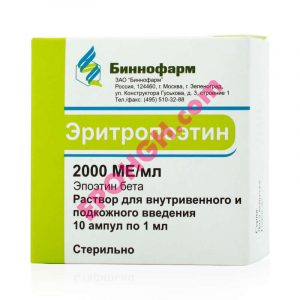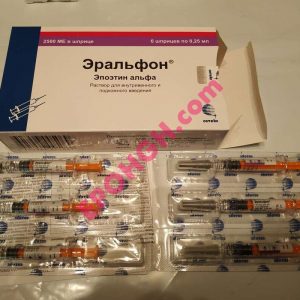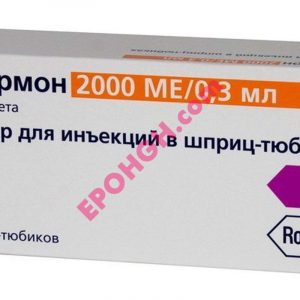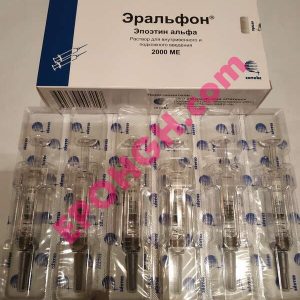$220.00
Description
pharmacological group: Glycoproteins, Erythropoiesis Stimulators Erythropoietin is a glycoprotein produced in the kidney that is responsible for stimulating the production of red blood cells. Epoetin alfa is a pharmaceutical form of erythropoietin made using recombinant DNA technology. The substance is made from animal cells into which the gene that codes for human erythropoietin is inserted. The biological activity and structure of epoetin alfa do not differ from human erythropoietin. Epoetin alfa is used to treat various forms of anemia. The substance effectively stimulates and maintains erythropoiesis in most patients. The drug's effectiveness quickly made it a ready-made replacement for older (less effective) drugs like Anadrol. Aerobic athletes use darbepoetin to produce red blood cells. It is no secret that blood doping has been practiced in endurance sports for many years. This procedure involves the isolation of the athlete from the body and the subsequent storage of a certain number of red blood cells for later transfusion. When these cells are added to the body prior to competition (by which time the body will have restored the lost blood volume), the athlete's blood contains a higher concentration of red blood cells. Therefore, the blood begins to carry oxygen more efficiently and the athlete's endurance increases significantly. The procedure can be quite risky, as the correct storage and use of blood is quite a complicated process. Epoetin alfa is a drug that basically complies with chemical blood doping and can achieve the same goals (increasing red blood cell concentrations) as simple drugs.
Alternative Steroid Names: Epogen, Erythropoietin, EPO, Eprex, Epoetin, Prokrit, NeoRecormon, Darbepoetin, Aranesp, Epogen, Erythrogen, Gemax, Hypercrit, Pronivel, Recormon, Kulat, Eripo, Eritina, Gemax-Erythron Bioein, Erlan, Epotin, Eposino, Dainepo.
Erythropoietin in sports
Erythropoietin is a common occurrence in sports: athletes depend on EPO because it is responsible for the production of red blood cells. It is no secret that among sports that test the endurance of athletes, so-called 'blood doping' is widespread. This procedure involves removing some of the blood from the body in order to store it and then replace it. Just before the competition, athletes add stored blood to the body (the body at this time is only restoring the lost amount of blood), due to the fact that they have a much higher number of red blood cells. Therefore, the blood transports oxygen throughout the body much better, due to which the athlete receives a noticeable increase in endurance.
So the hormone erythrothene is undoubtedly for many athletes a fine line between victory and defeat. However, the procedure involving erythropoietin doping is very risky. Blood is difficult to pool and difficult to manage, not to mention the problems that can occur as a result of too many red blood cells. Some of the risks are mitigated by EPO, a drug often equated with chemical blood doping. Storing and introducing blood may not be a concern, but red blood cell count problems can be very dangerous. If the drug is used incorrectly, the concentration of bodies can reach an extreme level, and this threatens the life of the athlete. You can have a heart attack, stroke, seizures, lethal cases are known.
There are also a number of side effects associated with the use of the hormone erythropoietin.Due to the change in the number of red blood cells, blood pressure may increase, followed by headaches. In addition, flu-like symptoms appear: the bones ache, there is a chill. It is possible to irritate the injection site. Since athletes are not using erythropoietin as directed by a doctor, serious side effects should be a signal to stop using the drug. There is no need to risk your health for the sake of sports passion.
Erythropoietin is sold as a liquid for injection, and can be taken subcutaneously (between the skin and muscle) or intravenously. Each of these routes of administration has a different effect on blood pressure. Through intravenous administration, the maximum level of blood pressure is reached as quickly as possible. The half-life is also not long, around 4-5 hours. When administered subcutaneously, the drug will raise pressure for a maximum of 12 to 18 hours. In an equal dose, this concentration will be much lower than if given intravenously. The half-life is also much longer, about a day. For clinical use, initial doses range from 15 to 50 units per kilogram of body weight three times a week. At this dose, an athlete weighing 70 kg will receive a maximum of 4000 units in one injection, i.e. 4 ml of the drug. The reception is designed for 2-3 days. Erythropoietin as doping should be taken several days or weeks before the competition, the maximum effect will be obtained on the eve of the competition.
The person taking the hormone erythropoietin should become familiar with the pharmacokinetics of the drug well before starting Epogen. A specific dosing schedule should be created so the athlete knows the best way to take Epogen with each injection. The schedule will help avoid complications that may arise due to the fact that the dose of the drug was inadvertently calculated at the last minute.The above dose in many clinical cases can vary up to 100 units per kilogram at a time, but athletes should be very careful about the dose. The possible side effects are very serious and should not be ignored. Remember that it is very important to monitor your blood cells while taking EPO. Keep your red blood cell count in the normal range to avoid serious complications.





